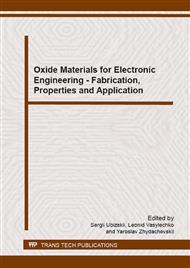[1]
F.F. Abdi, L. Han., A.H.M. Smets, M. Zeman, B. Dam, K. Roel, Efficient solar water splitting by enhanced charge separation in a bismuth vanadate-silicon tandem photoelectrode, Nature Commun. 4 (2013) 1-7.
DOI: 10.1038/ncomms3195
Google Scholar
[2]
D. K. Zhong, S. Choi, D. R. Gamelin, Near-complete suppression of surface recombination in solar photoelectrolysis by Co-Pi, catalyst-modified W: BiVO4, J. Am. Chem. Soc. 133 (2011). 18370-18377.
DOI: 10.1021/ja207348x
Google Scholar
[3]
S. Beg, S . Haneef, N.A.S. Al-Areqi, Study of electrical conductivity and phase transition in Bi2O3–V2O5 system, Phase Transitions, 83 (2010) 1114-1125.
DOI: 10.1080/01411594.2010.509642
Google Scholar
[4]
C. -C. Wu, K. -B. Chen, C. -S. Lee,.T. -M. Chen, B. -M. Cheng, Synthesis and VUV Photoluminescence Characterization of (Y, Gd)(V, P)O4: Eu3+ as a Potential Red-emitting PDP Phosphor, Chem. Mater. 19 (2007) 3278-3285.
DOI: 10.1021/cm061042a.s002
Google Scholar
[5]
B. Yan, X. -Q. Su, In situ chemical coprecipitation composition of hybrid precursors to synthesize YPxV1−xO4: Eu3+ micron crystalline phosphors, Mat. Scie. Eng. B 116 (2005) 196-201.
DOI: 10.1016/j.mseb.2004.10.004
Google Scholar
[6]
H. Zhu, H. Yang, D. Jin, Zh. Wang, X. Gu, X. Yao, K. Yao. Hydrothermal synthesis and photoluminescence properties of YV1-XPXO4: Eu3+ (X = 0-1. 0) nanophosphors, J. Nanopart. Res. 10 (2008) 1149-1154.
DOI: 10.1007/s11051-007-9339-y
Google Scholar
[7]
X. Zhou, X. Wang, Ca3(PxV1 –xO4)2 : Eu3+ Nanophosphor Synthesis, Controlled Microstructure, and Photoluminescence, Rus.J. Phys. Chem. A 87 (2013) 1859-1863.
DOI: 10.1134/s0036024413110307
Google Scholar
[8]
Slobodyanik, N. S.; Zatovskii, I. V.; Gorodilova, N. A. Characteristic features of crystallization in alkali metal (Na, K) phosphate vanadate flux systems containing calcium(II) and yttrium(III), Theor. Exp Chem. 46 (2010) 250 – 255.
DOI: 10.1007/s11237-010-9148-8
Google Scholar
[9]
M. Zhao, G. Li, J. Zheng, L. Li, H. Wanga, L. Yanga, Preparation and polymorph-sensitive luminescence properties of BiPO4: Eu, Part I: room-temperature reaction followed by a heat treatment, CrystEngComm, 13 (2011) 6251 – 6257.
DOI: 10.1039/c1ce05629h
Google Scholar
[10]
S. Zhang, Y. Yang, Hydrothermal Synthesis and Luminescent Properties of BiPO4: Eu3+ Phosphors, J. Elect. Mater, 43 (2014) 389-392.
DOI: 10.1007/s11664-013-2914-3
Google Scholar
[11]
M. Zhao, L. Li, J. Zheng, L. Yang, G. Li, Is BiPO4 a Better Luminescent Host? Case Study on Doping and Annealing Effects, Inorg. Chem., 52 (2013) 807–815.
DOI: 10.1021/ic3019315
Google Scholar


